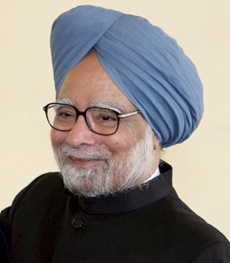PM blames US monetary policy for rupee’s woes
30 Aug 2013
 Prime minister Manmohan Singh today ruled out any reversal of his government's economic policies and denied plans to resort to capital controls to rescue the rupee that has fallen to historic lows.
Prime minister Manmohan Singh today ruled out any reversal of his government's economic policies and denied plans to resort to capital controls to rescue the rupee that has fallen to historic lows.
While volatile currency movements have been a cause of deep concern, the prime minister said the rupee's plight has been due mainly to the US Federal Reserve's plan to taper its monetary expansion.
He said the current economic situation in the country is difficult and the currency fall could also be in part due to the prevailing domestic economic uncertainties, the prime minister said, there could be no reversal of the government's economic policies.
Making a statement on the current economic situation in the country in the Lok Sabha, the prime minister said, ''The movement of the exchange rate of the Indian rupee recently has been a matter of concern. The rupee has depreciated sharply against the dollar since the last week of May. There are concerns, and justifiably so, of the impact this would have on our economy.
What triggered the sharp and sudden depreciation was the markets' reaction to certain unexpected external developments.
On 22 May 2013, the US Federal Reserve Bank indicated that it would soon 'taper' its quantitative easing as the US economy was recovering. This led to a reversal of capital flows to emerging economies which are now sharply pulling down not just the rupee, but also the Brazilian real, the Turkish lira, the Indonesian rupiah, the South African rand and many other currencies.''
"We are faced with challenges but we have the capacity to deal with them," he said, while seeking support of all political parties to take the economy out of the difficult situation.
On the decline of rupee's value, he said, there "may be short term shocks to our economy and we need to face them. That is the reality of the globalised economy, whose benefits we have reaped".
There is no question of reversing the policies just because there is some turbulence in capital and currency markets, he said, adding the "sudden decline in exchange rate is certainly a shock, but we will address this through other measures, not through capital controls or by reversing reforms".
The prime minister said while global factors such as tensions over Syria and the prospect of US Federal Reserve tapering its policy of quantitative easing have caused general weaknesses in emerging market currencies, the rupee has been especially hit because of our large current account deficit and some other domestic factors.
He, however, said the government intended to act to reduce the current account deficit and bring about an improvement in the functioning of the economy.
The prime minister also agreed that the current account deficit is unsustainable compared to the levels in 2010-11 and even in the crisis year of 2008-09.
The government, he said, has taken measures to reduce the current account deficit and the CAD could fall below $70 billion this financial year, as indicated by the finance minister.
''Our medium term objective is to reduce the current account deficit to 2.5 per cent of our GDP. Our short term objective is to finance the current account deficit in an orderly fashion. We will make every effort to maintain a macro economic framework friendly to foreign capital inflows to enable orderly financing of the current account deficit.''
"We have the more difficult reforms to do such as reduction of subsidies, insurance and pension sector reforms, eliminating bureaucratic red tape and implementing Goods and Services Tax," he said.
"These are not low hanging fruit and need political consensus... We need to forge consensus on such vital issues. I urge political parties to work towards this end and to join in the government's efforts to put the economy back on the path of stable and sustainable growth," Singh said.
On the fiscal deficit, he said, the government will do whatever is necessary to contain the fiscal deficit to 4.8 per cent of GDP this year.
The most growth-friendly way to contain the deficit is to spend carefully, especially on subsidies that do not reach the poor, and we will take effective steps to that end.
Clearly we need to reduce our appetite for gold, economise in the use of petroleum products and take steps to increase our exports.
All in all, the macro-stabilisation process which should support the value of the rupee is under way. I expect that as the fruits of our efforts materialise, currency markets will recover.













.jpg)






.jpg)









